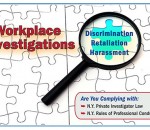NYPRR Archive
Category Archive

Current Issue, NYLER Archive, NYPRR Archive, Uncategorized •
admin •
Comments Off on Why the “Stock” Decision Is Wrong — And Why It Is Right
By Ronald C. Minkoff Like so many New York lawyers, I was happy when the First Department decided Stock v. Schnader Harrison, Segal & Lewis, LLP, 35 N.Y.S.3d 31 (1st Dept. 2016 (Stock). Indeed, I was probably happier: The First Department’s decision, which applied the attorney-client privilege to cover all communications between a law [&hellip...
Read More

Current Issue, NYLER Archive, NYPRR Archive, Uncategorized •
admin •
Comments Off on Virtually Unclear: Will Legal Tech Companies Bridge Justice Gap or Fall into UPL Abyss?
By Nicole I. Hyland and Tyler Maulsby In 1965, Norman F. Dacey published a book, How to Avoid Probate, which sold 600,000 copies in two years. New York Cty. Lawyers’ Assn. v. Dacey, 54 Misc.2d 564 (N.Y. Sup. Ct. 1967) affd. in part, modified in part, 28...

Current Issue, NYLER Archive, NYPRR Archive, Uncategorized •
admin •
Comments Off on Understanding & Securing the LLP Shield in New York (Part 2)
By Susan Fortney As Part 1 of this article suggested (see NYLER June 2015), many lawyers jumped on the limited liability partnership (LLP) bandwagon without fully appreciating the reach of the statute that enabled lawyers to practice in LLPs and the...

Current Issue, NYLER Archive, NYPRR Archive, Uncategorized •
admin •
Comments Off on Tinker, Tailor, Lawyer, P.I.: Are Your Workplace Investigations Complying with the Law?
How Attorneys Conducting Workplace Investigations Can Comply with N.Y.’s Private Investigator Law & Rules of Professional Conduct By Ronald C. Minkoff, Lindsay Harris, and Andrew Jacobs The recent high-profile trial in Ellen Pao vs. Kleiner...

Current Issue, NYLER Archive, NYPRR Archive, Uncategorized •
admin •
Comments Off on Understanding & Securing the LLP Shield in New York (Part 1)
By Goldy Gluzman & Susan Fortney Introduction “[T]he actions of a partner you don’t even know, working in an office on the other side of the country, could cost you your house and force your kids to go to public school.” See, Michael Orey, “The...

Current Issue, NYLER Archive, NYPRR Archive, Uncategorized •
admin •
Comments Off on When Case-Within-a-Case Method Helps Plaintiffs Prove Legal Malpractice
By Daniel L. Abrams Causation is an essential element in any legal malpractice case. When the plaintiff alleges that an attorney mishandled a lawsuit, in order to prove causation the plaintiff must prove that it would have prevailed in the underlying lawsuit....

Current Issue, NYLER Archive, NYPRR Archive, Uncategorized •
admin •
Comments Off on When You Can Contact Others Who Are or Were Represented by Counsel: Part II
By Martin I. Kaminsky (Greenberg Traurig LLP) and Maren J. Messing (Patterson Belknap Webb & Tyler LLP) In Part I of this article, “When You Can Contact Others Who Are or Were Represented by Counsel” (NYLER April 2015), we explained the basic...

Current Issue, NYLER Archive, NYPRR Archive, Uncategorized •
admin •
Comments Off on “Remembering Professor Monroe Freedman”
By Abbe Smith The following remarks were delivered on March 1, 2015, at the Memorial Service for Professor Monroe Freedman. Monroe was my friend, co-author, intellectual life partner, mentor, and member of the family. There is no one like him; he is...

Current Issue, NYLER Archive, NYPRR Archive, Uncategorized •
admin •
Comments Off on When You Can Contact Others Who Are or Were Represented by Counsel: Part 1
By Martin I. Kaminsky (Greenberg Traurig) and Maren J. Messing (Patterson Belknap Webb & Tyler) Lawyers sometimes want to contact a person who is connected with an adverse party or formerly connected with an adverse party in a transaction or litigation....

Current Issue, NYLER Archive, NYPRR Archive, Uncategorized •
admin •
Comments Off on “Illegal” Conduct Under Rule 1.2: When Does Advice to a Client Violate an Attorney’s Ethical Obligations?
By Lewis Tesser and Timothy Nolen Many attorneys have experienced situations in which a client has sought advice about proposed actions which “push the legal limit” or are even clearly illegal. How far—if at all—may attorneys go in assisting a client...
